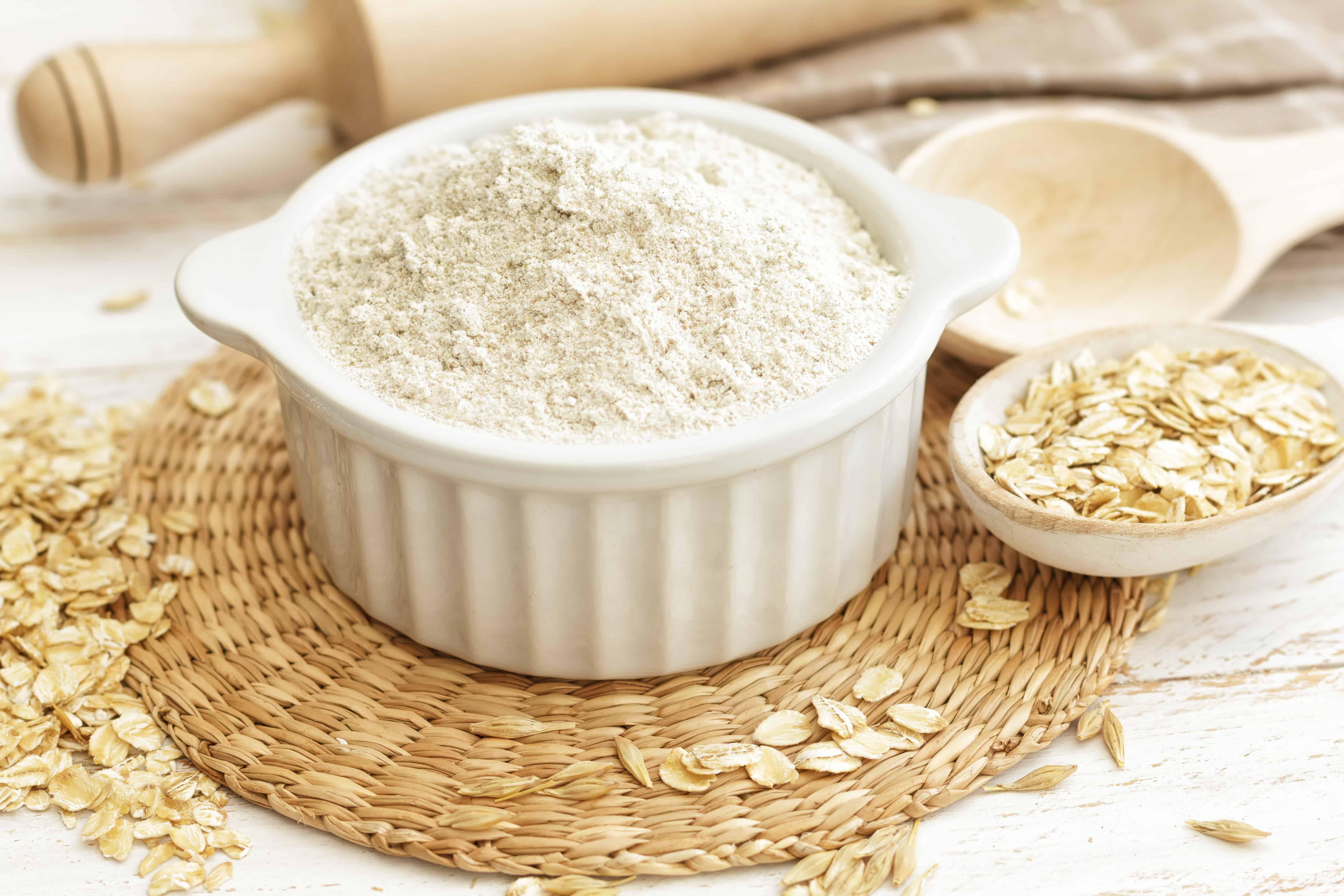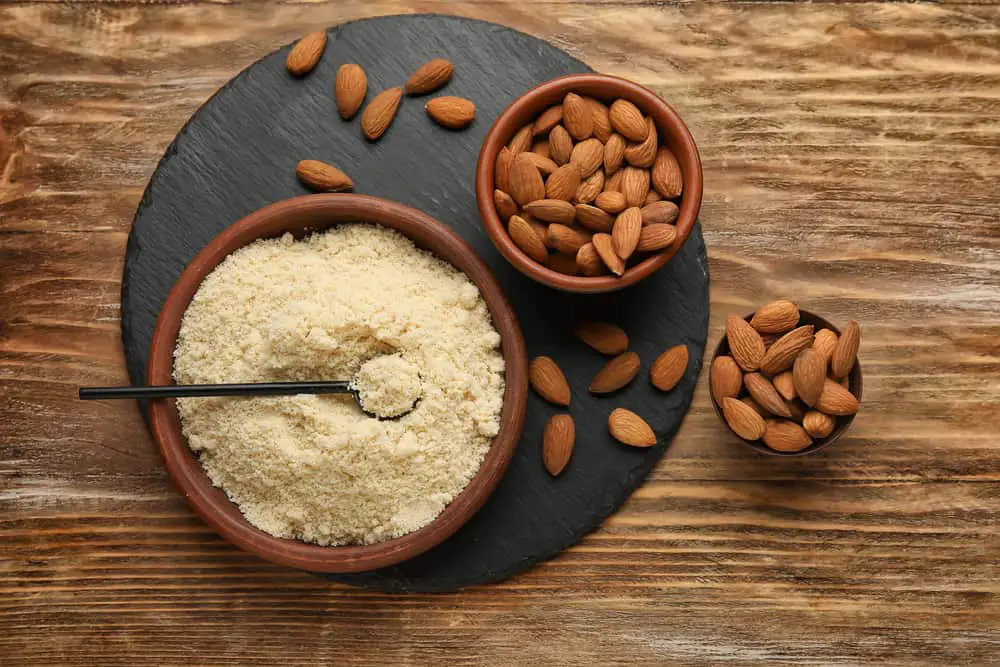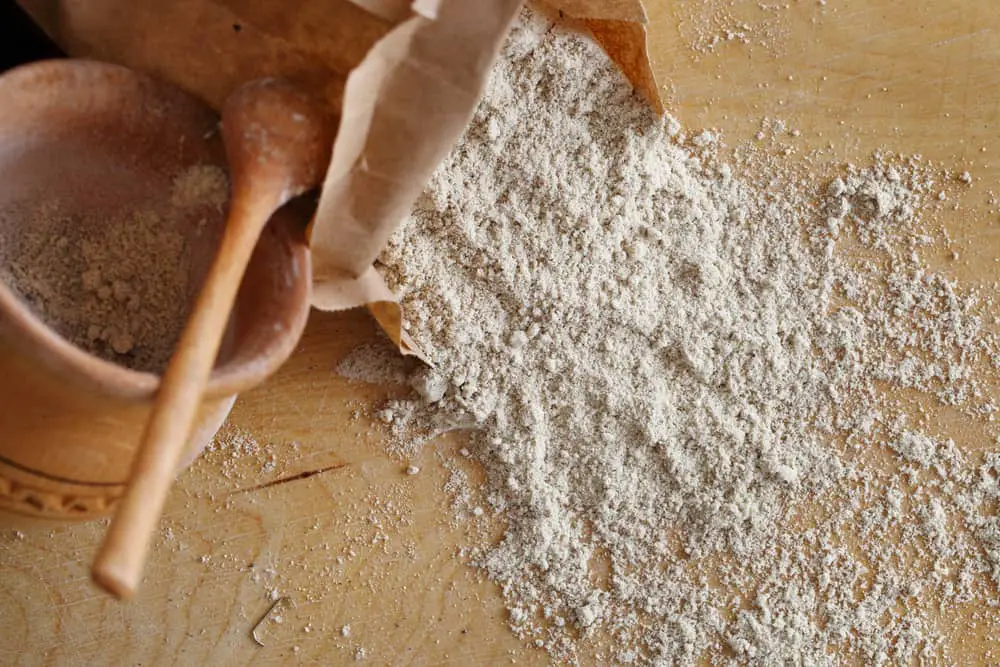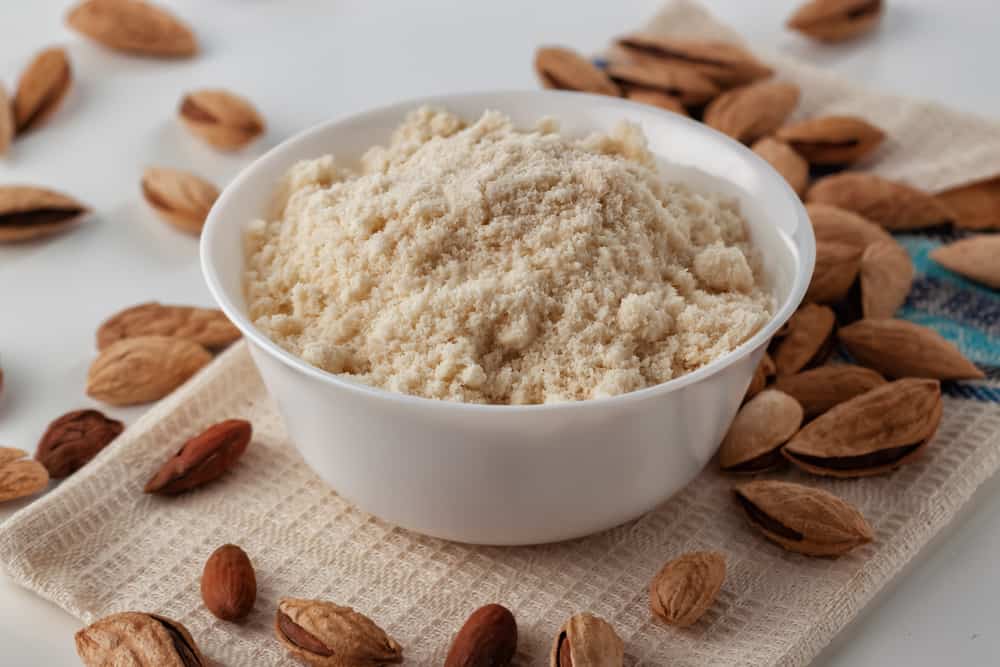What is Almond Flour?
Almond flour is a paleo-friendly flour made from ground almonds. It’s very versatile and can be used to make anything from baked goods, pasta, fruit crumble toppings, pie crusts, and all sorts of sweet treats.
Almonds are high in healthy fats and contain fiber, protein, vitamin E, magnesium, and calcium. They also have fewer carbohydrates than many other nuts. This makes them a good choice for low-carb diets like keto.
How is it Different from Other Types of Flour?

Today, many individuals still believe that almond flour and wheat flour are the same white powder. This is not the case. Many things make almond flours different from other types of flour. For instance, almond flour is quite high in fat compared to other flours, at around 66 percent. This is because it’s made from ground almonds, naturally high in fat. Most types of flour are lower in fat, consisting of only around 15 percent or less.
Also, unlike other types of flour, almond flour doesn’t contain any gluten. This is because it’s made from almonds, which are naturally gluten-free. Other types of flour may contain some gluten, making them an unfavorable choice for those who suffer from celiac disease or have gluten sensitivity.
Rice Flour vs Almond
If you want to make gluten-free meals, rice flour and almond flour are excellent alternatives. However, the similarity ends here as both come from different resources. Rice flour comes from finely milled rice, whereas almond flour comes from ground almonds. The flavor of rice flour is mild, with a hint of nuttiness that complements most meals.
Almond flour has a slightly more noticeable flavor and contains some bits of almond skin. Nutritionally speaking, rice flour has more carbs than almond meal. It’s also lower in protein and higher in fat, making it a less ideal option for pairing with sugar-free meals.
Chickpea Flour vs Almond
Chickpea flour is an excellent substitute for almond flour in recipes that call for it. This is because both flours are gluten-free and have a nutty flavor. However, the key differences between the two include carbohydrates, protein, and fat content.
Chickpeas naturally contain more carbs than almonds, while almond flour contains more protein and only one percent of its calories come from fat compared to chickpeas, which have three percent of their total calories from fat. In other words, when it comes to a battle of these two flours, the almond variety beats chickpea when it comes to nutritional value.
Can I Sub Oat Flour For Almond?

Almond flour and oat flour can be used interchangeably in many recipes. This is because both flours contain similar amounts of dietary fiber and protein, which makes them comparable substitutes.
Can I Substitute Almond for White Flour?
If you’re trying to reduce the number of carbohydrates in your diet, it’s a good idea to substitute wheat flour for almond flour. This is because white flour only has about 80 percent carbs instead of 100 percent carbs found in its almond counterpart.
Density
Almond flour is denser than wheat flour. It has twice the amount of protein, eight times more fiber, and fewer carbs than traditional white or whole-wheat flours. Almonds are nutritious nuts that contain many healthy fats, vitamins, antioxidants, and minerals.
Almond Flour Conversions
One cup of wheat flour = 140 grams. Therefore it makes sense that 1 cup of almond flour = 95 grams. In metric, 1 cup of almond flour = 125 grams. In US cups, 1 cup of almond flour = 5 ounces. Here’s a handy conversion guide for almond and white flour.
- If a recipe calls for ¼ cup white flour, use ½ cup almond
- If a recipe calls for 1 cup white flour, use 2 cups almond
- If a recipe calls for 2 cups white flour, use 4 cups almond
How Many Ounces in a Cup of Almond Flour?
One cup weighs 3.39 ( ~ 3 1/3) ounces (or precisely 3.3882342075198 ounces).
How Many Cups in a Pound of Almond Flour?
One pound equals 4.72 cups.
Almond Flour Weight Per Cup
One cup weighs 96.1 grams or precisely 96.054824019 grams.
Almond Flour Cups to Grams
One cup is equivalent to 96.1 grams.
Is Almond Flour Self Rising?

It is not self-rising! It doesn’t contain any added leaveners, such as baking soda or baking powder, essential to making a baked good rise when heated. This means that you will need another type of leavening agent in your recipe.
How to Make Self-Rising Almond Flour
Making your own self-rising flour is simple, as long as you have a food processor. Simply combine your almond meal with baking powder and salt in a mixer, or process it in a blender if you don’t have a food processor.
This will last for two months if stored in the refrigerator or three days at room temperature.
Sifting Almond Flour
You need to sift your flour for some recipes before using it. In order to get your flour sifted, be sure that you have a fine-mesh strainer and a bowl. Measure out the amount of flour you need. Then, pour it into the strainer and shake it back and forth over a bowl until all larger pieces are gone. Make sure that none of the small pieces end up in your bowl, or they will be challenging to measure later.
Why is this important? Sometimes, you’ll notice lumps of ingredients when making certain recipes. For example, if you’re making a pie crust with almonds as part of its ingredients, you may see some lumps in your dough. Generally speaking, these lumps are caused by pieces of flour not having been sifted. The lumps are caused when pieces of almond flour touch one another and are too small for you to see. This is why it’s important to sift before measuring out your flour, or else you’ll end up with a lumpy dough that won’t turn out the way you intended.
How to Sift Almond Flour Without a Sifter
The most popular replacement for a flour sifter is a fine mesh strainer. For sifting this flour, use a mesh strainer. This will allow you to separate tough lumps from fine flour for a smooth baking experience. A whisk attachment for an electric mixer works and any other method if you have one available.
Most homes have at least one of these utensils already stashed away in the back of a kitchen cabinet. A mesh strainer works out perfectly to remove tough lumps and create a smooth consistency for your baking needs.
A food processor can also turn your flour into a fine powder without any lumps. This is a great alternative method of ensuring you get a smooth result every single time! This method takes around 15 minutes.
Historical Background of Almond Flour

Almond flour, a type of nut flour, has been used to make bread and other baked goods since the Middle Ages. To better understand its properties as an ingredient in baking, it is important to first look at the history behind this nut flour.
Almonds were one of the earliest cultivated nuts; historians believe this may have happened as far back as 6000 BC in Asia Minor. By 1000 AD, almonds spread throughout all regions grown today. Subsequently, almond cultivation became popular throughout Europe, especially in France, which remains one of the top producers of almonds worldwide. Almond flour has remained a staple in many regions and has seen a resurgence in popularity over the past few decades in the United States.
Interesting Tidbits
The almond tree is of the genus Prunus, which includes cherries, apricots, peaches, and plums. The seed of the almond tree may be referred to as almond nut or simply almond. Almonds are an ancient crop with archaeological evidence showing their use by humans going back 6500 years!
Well-Known Brands
Almond flour is a great low-carbohydrate, high-protein, and high-fiber alternative to wheat flour. It can be used as a substitute for all-purpose flour in many recipes. The taste of this flour will enhance the flavors of your baked goods, so it’s best to use strong flavors such as vanilla or chocolate when using this flour.
Be sure you know beforehand that this nutty flour is not interchangeable with coconut or other nut flours. There are many popular brands out there. You will find them in grocery stores, health food stores, and online.
Here is a list of the most popular brands:
- Bob’s Red Mill Superfine
- Whole Foods Market 365
- Blue Diamond
- Honeyville Farms Blanched
- King Arthur
- NuNaturals Vanilla Flavored
- Trader Joe’s
What is the Best Almond Flour?
It is quite challenging to tell the best out of all the different brands available. It depends on your personal preferences. There are many factors that people may look at when finding the best almond flour for their needs. These factors include taste, price, brand reputation, and the manufacturer’s grade.
Every recipe requires a different amount of flour, too. If you’re baking a very dense product, then less will be needed than something as thick or heavy.
The ingredients included in the recipes you bake also must be taken into account before deciding which brand would work best for you. This means making sure there are no food allergies or intolerances to any of the ingredients that are included in your recipe.
Also, if you’re baking for someone who has dietary restrictions, then you’ll need to make sure that all ingredients are gluten-free and Paleo-friendly. Many different brands sell both these types of almond flours to accommodate individuals with special dietary needs.
What is the Best Almond Flour For Baking?

It is a common question, but one with no definite answer. There are many kinds of almond meal/flour to choose from, making it difficult to know which type will yield the best results in your baking. The variety of flours is rooted in how almonds are processed into flour form – blanched, unblanched, or sliced and then ground into powder.
Almond flour can be used in recipes interchangeably with other types of groundnuts. However, there’s more to gluten-free flour than just how it looks when you buy it. The texture and performance can vary greatly among these different options for grinding up almonds. This flour is a great thing to have on hand since it is a versatile ingredient and can be used in many gluten-free recipes as a substitute for regular all-purpose wheat flour. There isn’t one type that will work best for every recipe, but you can get close if you buy the right kind!
Blanched vs. Unblanched
People often ask what the difference between these two kinds is and which one you should use in your baking. The answer depends on what specifically you’re looking for in your finished product.
Blanched almond flour has been milled from blanched almonds. Blanched almonds are a variety that has a lighter color and sweeter taste compared to other varieties of the nut that come from darker colored, more strongly flavored raw almonds. Because they’re larger and contain less water, they yield a finer ground product. This results in a more velvety texture for baked goods made with this type of flour than those made with unblanched almond flour.
Unblanched almond flour is made from whole raw almonds (with their skins intact). It has a slightly granular texture which helps it absorb more liquid than its blanched counterpart. Whole unblanched blanched almonds can be used to make your flour by grinding them in a food processor to the desired consistency. This saves you money and lets you get control over how finely ground or coarsely textured your flour is.
Best Almond Flour for Macarons
Macarons are intricate French confections known for their smooth shells, airy innards, and subtle flavor. When it comes to creating the perfect macaron, every detail counts. This includes using quality ingredients that have been properly combined to create the best almond flour macarons. While this may seem like a daunting task, knowing which ingredients work well together can quickly take your macarons from mediocre to magnificent.
A popular brand for those seeking the best flour for macarons is Bob’s Red Mill 1.

Best Super Fine Almond Flour
First off – you should know that there are two types of almond flours: whole ground and finely milled blanched super fine.
The whole ground almond meal contains bits of the almond with the almond skin still intact, and it has a higher fiber content. For those of you who don’t like the bits of almonds in your flour, this super fine blanched almond flour is what you want. The ground almond meal also absorbs more liquid than the super fine almond flour. The superfine almond flour is typically more expensive than the ground almond meal because it requires grinding the almonds twice (once to remove the skin and again to make the flour). The best super fine almond flour is typically finely milled and will provide a light, fluffy consistency, and the taste is very mild – similar to that of wheat flour.
How is Almond Flour Made?
You might have already guessed, but this flour is made by finely grinding almonds. The almonds are first blanched to remove their skins. Then, they are ground into a paste, which is sieved to separate the coarse meal from the fine flour. Finally, any powder that remains after sieving is re-milled and sieved again to produce pristine white flour free of dark particles.
What Does Almond Flour Taste Like?
This flour has a slightly sweet and nutty taste. The taste can vary depending on the type of almonds used and how finely they are ground. Those who like the taste of almonds will likely enjoy its taste.
What Does Almond Flour Smell Like?
The smell is, not surprisingly, quite similar to ground almonds and therefore has a slightly nutty smell. The fragrance of almonds can vary depending on the type of almonds and how finely they are ground. Those who like the taste of almonds will likely enjoy the smell and taste.
How to Make Almond Flour

Almond flour is a popular low-carb, gluten-free alternative to wheat flour. It’s naturally high in protein and healthy fats while being extremely tasty! Making this flour is very simple if you have the right tools. However, this process can take up quite a bit of time, so it’s best to make large batches at once.
First, take your almonds and lay them out on a baking tray. You can use other nuts in place of the almonds; however, they must be blanched first to remove their skins. Make sure to rotate them while baking so that one side doesn’t cook faster than the other – usually, five minutes should do it for this step. Don’t burn the almonds!
Second, put your almonds or other nuts into a food processor. This is where you’ll start seeing the flour come to life! If the food processor gets too full with chunks of nuts, though, stop it immediately before burning out any components. After this step, sift your flour twice through different metal mesh colanders (or three times if using un-blanched almonds). Be sure that all large pieces are caught by the colanders.
Third, use a blender to break down any chunks leftover in the flour until it reaches desired consistency.
Fourth, put your blended flour onto an oven tray and bake at 150 degrees Celsius for 25 minutes. This step is very important! If you skip this or don’t do it properly, your almond meal will turn moldy after some time (if it doesn’t grow mold immediately).
Fifth, once baked, allow your finished product to cool off completely before using/storing them in an airtight container or jar. Now you’ve got yourself DIY blanched almond flour!
How to Blanch Almond Flour
Blanched almond flour/meal is made by blanching almonds in boiling water for 30 seconds, then peeling off the skins. This makes it so that you have a more pure form of flour without the extra fiber of the skin surrounding your almonds – this can alter the taste slightly. Unblanched flour does not have its skin removed, making it more bitter and more challenging to work with.
Blanched vs Unblanched Almond Flour
Unlike unblanched almond meal, blanched almond flour has had the skin removed. As a result, blanched flour is more refined in texture and has a more subtle taste, while unblanched still has the darker brown on its outer layer. Unblanched almond flour will have a slightly stronger taste, which can be overwhelming when used in large quantities, but gives dishes a nice nutty flavor.
When it comes to blanched or unblanched, those who prefer less of a nutty taste go for blanched, while those who prefer more of a deep, rich flavor go with the unblanched variety.
Basic Numbers
Calories per 100 g: 583
Carbs per 100 g: 21.6g
Sodium per 100 g: 1mg
Protein per 100 g: 21.6g
Sugar per 100 g: 4.4g
How Many Carbs in One Cup of Almond Flour?
One cup contains 22g of total carbs.
Is Almond Flour Gluten-Free?

While the amount of gluten varies between brands, almonds do contain gluten. However, gluten is mostly very low, making it an ideal option for people with gluten sensitivities.
What is the Gluten Content?
Some brands contain small amounts of gluten. Even so, generally the gluten content is very low. If you want to avoid all gluten, look for one of the many brands that manufacture gluten-free.
Is Almond Flour Healthy?
Almond flour is a healthy alternative for those who cannot tolerate gluten or lower their carbohydrate intake. Almonds also contain Vitamin E & manganese, and fiber and protein content, which can help you feel even fuller after eating!
Are Additives Included?
Yes: always check the ingredients list – your flour may contain other ingredients such as emulsifiers or preservatives.
Does it Help with Weight Loss?
While the research is limited, some studies have shown that almonds can help reduce waist circumference and body mass index (BMI) among overweight adults. Almonds are high in protein which helps build lean muscle tissue, helping to increase metabolism. Many consumers with weight loss goals use this flour as part of their diet to increase their protein intake without consuming excess calories from meats/animal products.
Is it Easy to Digest?
Since it contains fairly low carbohydrate levels, it may be easier for those suffering from digestive diseases such as irritable bowel syndrome, inflammatory bowel disease, or any other type of gastrointestinal disorder to digest.
How to Store Almond Flour
This flour has a pretty decent shelf life: it can last up to one year if stored properly. Store it in an airtight container in a cool dark place. Make sure you are storing it far away from light, as this may cause the oil inside the flour to go rancid.
Should You Refrigerate Almond Flour?

Yes, refrigerating or freezing is necessary for long-term storage and freshness – your flour should not be left at room temperature longer than two months.
Is it Safe to Eat Almond Flour?
Almond flour is a fairly safe product to consume. However, there are some concerns about the presence of aflatoxin in almonds. Aflatoxin is a mold that can cause liver damage and cancer in humans with prolonged exposure. While the FDA has stated that the presence of aflatoxin does not pose significant risks to most healthy adults, it is still important to monitor your consumption levels for this risk.
Does Almond Flour Go Bad?
Yes, it can go bad if not stored properly or exposed to humidity, affecting the flour’s oils.
How Long Does It Last?
Shelf-life: Up to 18 months If refrigerated – while ingredients may change, the shelf life should remain the same approximately if stored properly. At room temperature, almond flour should not be consumed past one year after opening the package.
What Can Almond Flour Be Used For?
Almond flour, also known as almond meal, is a high-protein flour frequently used in gluten-free and Paleo recipes. These delicious baked goods have a soft, moist texture that slumps slightly when touched. The batter may be very sticky or pasty and a bit hard to work with the first time you try it, but you can master the process after a few tries. This versatile flour can also be used to coat meats and vegetables before being fried in oil on the stovetop or oven-roasted.
Pancakes
Almond flour pancakes are a delicious breakfast treat. You can also try adding some chocolate chips or blueberries to the batter for an extra-sweet twist on this traditional favorite.
Just be sure to substitute coconut milk for regular milk – it has more fat and fewer carbs than cow’s milk, so your pancake will come out creamier and richer!
Biscuits
These little snacks are just as versatile as pancakes! They’re great with soups or stews, packed into lunchboxes, brought along on road trips, frozen for later consumption, or just eaten as is whenever you want something crunchy and salty without all the guilt of potato chips.
Bread
Almond flour/meal bread makes excellent loaves of bread for toast and sandwiches. You can also use it to make French toast or garlic bread and store the leftovers in the freezer for another day.
Waffles
Almond flour waffles are fantastic for any breakfast on the go!. If you have time for a more leisurely waffle experience, wrap them up with some fresh fruit and whipped cream, or add a little melted butter and syrup for a heartier breakfast treat.
Cakes and Cupcakes
You can make cakes, cupcakes, bundt cakes, angel food cakes, pound cake; the sky’s the limit when it comes to what you can make using this magical flour! You’ll never miss traditional wheat-flour desserts again after trying these amazing alternatives.

Almond Flour in Macarons
Using this flour in macarons is a common topic for bakers. The reason why is because not all flours are created equal, and if you’re using the wrong kind, then your macarons probably won’t turn out as planned.
Use a flour that has been blanched (skinned), not unblanched. Unblanched flours will work too if that’s all you have access to, but this type of flour tends to result in little brown spots in your macarons and, therefore, not as pretty when finished baking.
For macarons, flour with a high protein or moisture content should also be avoided. Just keep in mind that it’s best to choose flours with lower protein and moisture contents because this type of flour is more finely balanced throughout, so your macarons will come out perfectly.
Do You Have to Use Almond Flour for Macarons?
Almond flour is a popular substitute for sugar in desserts, replacing it with an almond-based alternative that provides similar sweetness and consistency to the original recipe. Perhaps this is why some traditionalists believe that only almond flour will do when making macarons.
So, do you have to use this flour for macarons? The simple answer is no – but there are some good reasons why you might want to try using it anyway. For instance, the flavor is more neutral than ground almonds, which can result in better-tasting macarons.
Substitute for Almond Flour in Macarons
Again, a common ingredient in the preparation of macarons is almond flour. However, this ingredient is not suitable for people who are allergic to nuts or have issues with nut-based nourishment. Some pastry chefs also use wheat flour and cornstarch as substitutes; both work very well in achieving a smooth texture and balanced flavor in baked goods such as cookies and macarons.
Wheat Flour
Use equal amounts of white all-purpose flour and wheat flour in place of almond meal, which will ensure that your cookies turn out crispy and delicious every single time. However, some pastry chefs prefer adding a bit of granulated sugar into the mix. This can be done by mixing one-quarter cup of white sugar with every one-cup measuring wheat flour.
Cornstarch
Using cornstarch is another effective substitute for almond meal in macarons. This is because cornstarch helps hold the macarons together and provides them with the much-needed crunchy texture.
Substituting these ingredients can be tricky, especially if you do not have enough experience preparing macarons. However, if you follow your recipe to the letter by using equal measurements and consistent procedures for incorporating each ingredient, you will be able to make delicious macarons.
Almond Flour Crepes

When you want to try something new, low-carb crepes are a great example. This is an easy recipe to whip up, and you can even make a few of them ahead of time and keep them for later. In addition, you can find many recipes online, which are easy to follow.
Can You Make Blondies With Almond Flour?
Yes, this flour can be used to substitute for wheat flour which is usually used to make blondies. The end product will be healthier than the regular one, which is great for people on a diet.
Can You Make Banana Nut Muffins With Almond Flour?
Yes, this flour can be used in place of wheat-based flour to make all sorts of desserts and baked goods, including banana nut muffins. However, you may need to use more than one egg when baking with almond product.
Can You Make an Almond Flour Angel Food Cake?
Yes! It has the same structure as a traditional flour-based one; it’s just made with different ingredients.
Can You Make an Almond Flour Fruitcake?
Typically, this flour is not sufficiently fatty or absorbent to be used in a fruitcake recipe. However, you can still use it in a traditional fruitcake by following the recipe on the package. Each manufacturer’s formula will vary, so you may need to add more liquid or use less flour than the recipe calls for if your batter is too dry or thick.
Can You Make an Almond Flour Buttermilk Pancake?
Yes, you can make an almond flour buttermilk pancake. It will be denser than one made with wheat flour; however, it should still taste delicious.
Can You Make Linzer Tarts With Almond Flour?
Yes, you can make Linzer tarts using this flour. While the dough may be slightly more crumbly than traditional pastry dough (made with wheat), it should still be workable and delicious! You may want to try adding a bit more butter to reach the desired consistency.
Can Almond Flour be Used For Anything?
One common question is whether or not this flour can be used for anything. The answer? Absolutely!
This nutty flour is a versatile baking ingredient and can be used for many different recipes. You can use it instead of wheat flour in most recipes, and you can even use it as a breading or coating agent. In addition, this flour is nutty, so pairing it with savory flavors will give your dish more of a bite-that is also excellent for dishes that need some extra flavor.
Recommended Uses

This superpowered flour is perfect for cakes and cookies because it lends a very moist and rich flavor that complements traditional sweet baking ingredients such as butter, sugar, and other tasty things.
Some of the recommended uses in baking are cakes, cookies, bread, muffins, pancakes, and waffles. The possibilities are endless! Not only are there health benefits involved with using this flour in baking or cooking, but it is also very versatile, and you can use it to thicken soups and add a lighter texture to the dish.
This flour is often used as an alternative to traditional wheat flour when baking; however, it can also be used as a tasty addition to the outside of anything you are frying up, like chicken-fried steak or fish.
Can you tell we love our almond flour? We hope you do, too!
